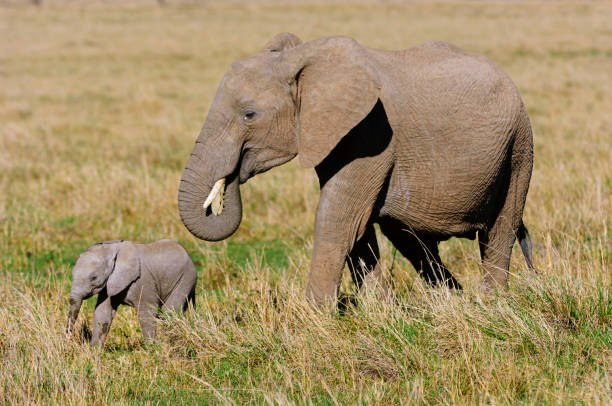Sound is one of the most profound ways the natural world communicates. It travels through air, water, and even the ground, carrying secrets, warnings, songs, and survival cues. For humans, hearing defines much of our connection to the world—but in the animal kingdom, it’s elevated to an art form. Some creatures can hear frequencies far beyond our imagination, detecting whispers of danger or songs of love from miles away.
Hearing is not merely a sense for these beings—it’s their compass, radar, and lifeline. Whether they use it to hunt in pitch-black nights, communicate across vast oceans, or detect the flutter of wings in the dark, these animals possess superpowers that challenge our understanding of biology and perception.
Let’s journey through the extraordinary world of ten animals whose hearing abilities surpass the limits of human comprehension. Their stories reveal the elegance, mystery, and brilliance of evolution itself.
1. The Greater Wax Moth – The Ultrasonic Master
It might surprise you that one of the world’s greatest listeners isn’t a mammal or bird but a tiny, delicate moth. The Greater Wax Moth holds the record for the highest frequency hearing of any known animal on Earth.
Humans can hear sounds between 20 Hz and 20,000 Hz (20 kHz). Bats, known for their ultrasonic echolocation, can detect frequencies up to about 100 kHz. But the Greater Wax Moth? It can hear sounds up to a staggering 300 kHz—fifteen times higher than what we can detect.
Why would a moth need such incredible hearing? Evolution crafted this ability as a defense mechanism. Bats hunt at night using ultrasonic calls, and moths evolved ears sensitive enough to detect those calls and evade predation. In essence, the wax moth’s ears became fine-tuned radar detectors, able to sense even the faintest signals of danger in the dark.
Despite its fragile body and short lifespan, this little moth embodies one of nature’s greatest feats of sensory engineering—a testament to how survival can sculpt perfection from simplicity.
2. The Barn Owl – The Silent Hunter of the Night
The Barn Owl is a ghostly figure of grace and precision. Floating silently through the night, it hunts not by sight, but by sound. Its hearing is so refined that it can locate a mouse in complete darkness purely through the rustle of grass or the faint scratch of tiny claws.
The secret lies in its facial structure. The Barn Owl’s face acts as a radar dish, funneling sound waves toward its asymmetrical ears—one slightly higher than the other. This uneven placement allows the owl to detect the direction and elevation of a sound source with pinpoint accuracy.
Its brain processes these auditory cues in milliseconds, creating a 3D sound map of its surroundings. Experiments have shown that even with its eyes covered, a Barn Owl can strike prey with over 95% accuracy.
In the quiet of night, it is both ghost and predator—proof that silence and sound, when perfectly balanced, can create an apex hunter of haunting beauty.
3. The Dolphin – The Sonar Genius of the Sea
Beneath the shimmering waves, dolphins live in a world defined by sound. Water carries vibrations much faster and farther than air, and dolphins have evolved to use this medium to extraordinary effect.
Their super hearing is intertwined with a biological marvel called echolocation. Dolphins emit high-frequency clicks that bounce off objects and return as echoes. Their brains interpret these echoes to identify size, shape, distance, and even internal structure. It’s as if they “see” with sound—constructing a living image of the ocean in their minds.
Dolphins can hear frequencies up to 150 kHz, far surpassing humans. They can detect the sound of a fish’s heartbeat, the flutter of a fin, or the hollow sound of a hollow object underwater. Some scientists believe they can even recognize individual humans by the unique pattern of bubbles and sounds we make while swimming.
To a dolphin, the ocean is not silent—it is alive with stories written in echoes, each note a line of connection between intelligence and instinct.
4. The Elephant – The Earth Listener
While we think of elephants as giants who rely on sight and touch, they are also masters of low-frequency hearing. These gentle titans communicate using infrasound—vibrations below the range of human hearing (typically under 20 Hz).
An elephant’s massive ears are not just for cooling; they’re powerful acoustic receivers. But the most fascinating part of their hearing lies in their feet. Elephants detect deep rumbles and seismic vibrations through sensitive nerve endings in their feet and trunks. These signals travel through the ground and can be detected from several miles away.
Elephants use this subterranean language to stay connected across long distances, coordinating migrations, warning of danger, or calling for mates.
Imagine hearing the footsteps of a distant thunderstorm as a conversation rather than noise—that’s the world of an elephant. Their hearing is not just about survival; it’s about maintaining the emotional bonds that define their deeply social lives.
5. The Bat – The Night Navigator
No list of extraordinary hearing would be complete without the bat, nature’s original sonar engineer. Bats have evolved one of the most sophisticated acoustic systems in the animal kingdom—echolocation.
By emitting high-frequency calls (often between 20 kHz and 120 kHz) and analyzing the returning echoes, bats can map their environment in total darkness. They can detect the texture of leaves, the speed of flying insects, and even the movement of air currents.
Their auditory cortex—the part of the brain responsible for processing sound—is among the most advanced in any mammal. Some species, like horseshoe bats, can detect frequency changes as small as 0.1 Hz, allowing them to track a moving insect with surgical precision.
To humans, the night may seem silent. To bats, it is a symphony—a world rich with layers of sound and meaning, each echo painting an invisible picture of the night sky.
6. The Cat – The Whisper Catcher
Every cat owner knows the uncanny ability of their feline to appear the moment you open a can or whisper the word “treat.” But a cat’s acute hearing goes far beyond domestic mischief—it’s an evolutionary gift crafted by millions of years of predation.
Cats can detect sounds from 48 Hz to about 85 kHz, more than four times the upper limit of human hearing. Their ears rotate independently up to 180 degrees, allowing them to pinpoint sound sources with surgical accuracy.
This ability is critical in the wild, where cats hunt small prey like rodents, which often communicate and move at ultrasonic frequencies. A cat can hear the squeak of a mouse or the flutter of an insect’s wings long before it sees movement.
Their world is a tapestry of quiet whispers—a realm of rustling leaves, hidden footsteps, and the softest vibrations of life. Every sound is a story, and every twitch of their ear is a chapter turning in the book of survival.
7. The Pigeon – The Navigator of Sound
The humble pigeon, often overlooked in city skylines, possesses one of the most astonishing hearing ranges in the animal kingdom—especially for low frequencies.
Pigeons can detect infrasound between 0.5 Hz and 20 Hz, sounds so low that humans can’t perceive them. These infrasounds come from distant storms, ocean waves, or even geological shifts—natural phenomena that create vibrations traveling across hundreds of miles.
Scientists believe pigeons use this ability to navigate, sensing the low-frequency “hum” of the Earth to find their way home even from unfamiliar places. It’s like having a built-in global positioning system that operates on vibrations instead of satellites.
What we hear as silence, a pigeon experiences as a constant symphony of the planet itself—an invisible map of sound guiding it across continents.
8. The Fennec Fox – The Desert Whisperer
In the scorching silence of the Sahara, survival depends on listening. The Fennec Fox, with its enormous bat-like ears, is perfectly adapted to this unforgiving world.
Those ears, which can grow up to six inches long, aren’t just for dissipating heat—they’re extraordinary instruments of hearing. The Fennec can detect the faintest sounds of insects burrowing beneath the sand or small rodents scurrying underground.
Their auditory sensitivity extends across a wide frequency range, allowing them to isolate and interpret sounds in an environment where noise is scarce and echoes carry far.
To a Fennec Fox, the desert is never silent. Every grain of sand, every gust of wind, every tiny heartbeat beneath the surface tells a story. In this quiet expanse, sound becomes the language of survival.
9. The Beluga Whale – The Canaries of the Sea
Known as the “canary of the sea” for their melodious calls, Beluga Whales are among the most acoustically gifted creatures on the planet. They live in the Arctic’s dim, icy waters, where visibility is often limited, and sound becomes the primary means of perception.
Belugas produce and perceive a vast range of vocalizations, from high-frequency clicks used in echolocation to complex songs used in social communication. Their hearing range extends from 1 kHz up to about 123 kHz—allowing them to detect even the softest underwater vibrations.
These whales use sound to navigate icy labyrinths, locate breathing holes, and communicate with pod members over great distances. Scientists have even discovered that belugas can alter their pitch and tone to mimic other species or human-made noises.
In the silent vastness of the Arctic, belugas transform sound into connection—each song a thread weaving the community together beneath the frozen sea.
10. The Kangaroo Rat – The Desert Survivor
Deep in the arid landscapes of North America lives a tiny nocturnal rodent with a superpower—the ability to hear its predators before they even strike. The Kangaroo Rat’s survival depends entirely on its extraordinary hearing.
Owls, snakes, and foxes all prey upon this little mammal, yet it manages to evade them with astonishing agility. Its ears are tuned to detect the low-frequency sounds of approaching danger, especially the subtle wingbeats of an owl gliding silently above.
Its auditory system is so sensitive that it can distinguish between the echoes of its own footsteps and those of a predator. The brain of a kangaroo rat processes these cues in milliseconds, triggering lightning-fast escape responses.
In a world of predators, the kangaroo rat’s ears are its shield—an evolutionary triumph that turns hearing into an art of survival.
The Science Behind Super Hearing
Hearing is the perception of vibration. Every sound we hear, from the crash of thunder to a heartbeat, is a series of pressure waves moving through a medium—air, water, or earth. Animals have evolved countless ways to capture and interpret those vibrations.
The range of hearing depends on the anatomy of the ear and the environment an animal lives in. Aquatic animals, for example, evolved to hear high frequencies that travel well underwater. Land animals adapted to hear low-frequency sounds that move efficiently through air and ground.
Some, like bats and dolphins, actively produce sounds and interpret the returning echoes—a process known as echolocation. Others, like elephants and pigeons, detect infrasonic frequencies that reveal distant or seismic events.
The diversity of hearing mechanisms is staggering. Tiny insects like moths can detect ultrasound with microscopic membranes, while whales use complex skull structures to focus sound waves. Hearing, in all its forms, is a masterclass in nature’s adaptability.
The Emotional Symphony of Sound
To understand super hearing is to understand life itself. Sound is connection. It’s the warning of a predator, the cry of a mate, the pulse of an ocean wave, or the rhythm of footsteps across a savanna.
Animals with extraordinary hearing remind us that the world is filled with music we cannot perceive—a grand orchestra playing in frequencies beyond our reach. The flutter of moth wings, the low rumbles of elephants, the whisper of sand—all are parts of a living symphony.
In that realization lies something profound: we are surrounded by stories we cannot hear, voices of life that move silently around us every day. The Earth is not quiet—it’s singing. We are simply tuned to a narrow band of its infinite melody.
To open our minds to the hearing of other creatures is to rediscover the world—not as a human domain, but as a living, breathing concert of survival, emotion, and wonder.
In the unseen harmonies of the wild, the whispering moth and the roaring whale are equals—each playing its part in the timeless song of life.






